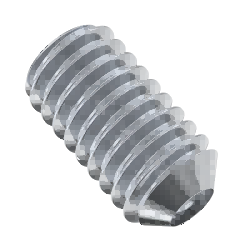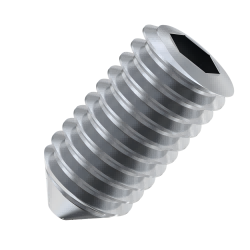Set Screw Sizes
• #00 - 6"
• M1.2 - M150
Set Screw Specifications
• ASME B18.3, DIN 913 / ISO 4026
• DIN 913 / ISO 4026
• DIN 914 / ISO 4027
• DIN 915 / ISO 4028
• DIN 916 / ISO 4029
A set screw is a type of fastener that is used to secure one object to another object without the need for a nut. It is typically a small screw with a pointed tip that is designed to penetrate into the surface of the object being secured.
Set screws are commonly used in applications where a precise fit is required, such as in machinery or in construction projects. They are often used to secure gears, pulleys, and other mechanical components to shafts or other objects.
Set screws come in a variety of sizes and materials, and can be made from stainless steel, brass, or other metals depending on the specific application. They are generally tightened with an Allen wrench or other hexagonal tool, and can be easily removed and adjusted as needed.
Set screws are typically used to secure one object onto another by pressing against the surface of the second object. The specifications of set screws may vary depending on the application requirements, but some common specifications are:
Material: Set screws can be made of various materials such as stainless steel, brass, aluminum, or plastic. The material used depends on the application, environment, and desired strength of the screw.
Size: The size of set screws is determined by the diameter and length of the screw. The diameter is measured across the widest point of the screw while the length is measured from the bottom of the head to the tip of the screw.
Thread type: Set screws can have various thread types such as standard UNC (Unified National Coarse), UNF (Unified National Fine), or metric threads. The thread type used depends on the mating threads and the application.
Point type: Set screws can have different point types, such as cup point, cone point, flat point, or knurled cup point. The point type used depends on the application and the surface it is gripping.
Head type: Set screws can have various head types such as socket head, flat head, or knurled head. The head type used depends on the application requirements, the tool used to install and remove the screw, and the desired appearance.
Tolerance: The tolerance of set screws specifies the allowable deviation from the nominal dimension of the screw. This specification is important in ensuring proper fit and function of the screw in the application.
Overall, the specifications of set screws must be carefully selected to ensure proper function and reliability in the application.
Set screws are available with with these points:
Cup Point |  | This is the most commonly used set screw and is identified by a cup-shaped indentation on one end. Cup points are typically used for a quick, semi-permanent or permanent applications where it is acceptable to cut the cup point edge of the screw. |
Cone Point |  | A cone point is easily identifiable by its sharp cone-shaped point – just like an ice cream cone. Cone point set screws deliver the strongest clamping force due to the deep penetration of the point. As a result they are used for permanent assembly. |
Flat Point |  | The cheapest and simplest of the set screw point styles, this screw has a flat surface on the bottom of the screw. This type is used when you need the ability to frequently change parts and require minimal shaft deformation. |
Set Screw Sizes
• #00 - 6"
• M1.2 - M150
Set Screw Specifications
• ASME B18.3, DIN 913 / ISO 4026
• DIN 913 / ISO 4026
• DIN 914 / ISO 4027
• DIN 915 / ISO 4028
• DIN 916 / ISO 4029
Contacto: Sino Special Metal Co., Ltd.
Teléfono móvil: 86-19527792928
Correo Electrónico: sales@ssmsteel.com
Whatsapp:86-19527792928
Dirección: Mudu town Jinfeng South Road, Wuzhong District, Suzhou City, Jiangsu Province
We chat
